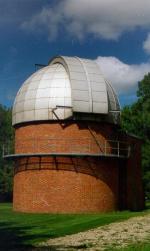| Warner and Swasey Observatory |
| Case Western Reserve University | Nassau Station |
| Visitors |
|
» Home » News » Gallery » Reference » Weather |
| Science Resources |
|
» NSRT User Interface » Software » Data Archive » Download Data |

|
 |
A practical guide to imaging filters for the NSRT
What does filter do?
You may want to start with our primer on photometry if you are unfamiliar with filters and what they are. In short, a filter is placed in front of the CCD camera in direct imaging mode and it allows some of the light at specific wavelengths (colors) pass through while blocking out all the other light.
Why would I want to use a filter?
Let's say that you want to know what color an object is. In this case you would want to take several exposures of the object using different filters. Then by comparing how bright the object appears in each image taken with different filters, you could say something about the spectral distribution (color) of the light coming from that object. We can sometimes use that information to make scientific inferences about the temperature or composition of the object.
We can also in some cases use the brightness of an object through a single filter to estimate how much total energy it is giving off in light or how far away it is. Single filters can also be used to isolate specific features in a complex object. Say we are looking at a nebula and we want to see the areas of hydrogen emmission. In that case we take a picture with a filter that isolates specific emmission lines of hydrogen and does not let any of the other light through.
 | It is important to remember that the light detected is a function not only of the filters but also the sensitivity of the CCD. The figure at left shows the relative amount of light detected through each filter as a function of wavelength. |
What filters should I use?
We suggest that you do not use any filter when taking images unless you have a good reason why you would want to use specific filters. Sometimes you'll be doing an experiment where filters will be needed to get the information you need from your images. However if you are just taking a picture, clear or no filter is the way to go.
The reason for this is simple, as we found out, filters work by letting only some of the light through while blocking the rest of the light. So when we use a filter we are throwing away some of the light, maybe a lot of the light. If the object you want a picture of is faint then you'll want to use every photon of light you can get to make that picture. By using the clear or no filter setting you are making the most of the light coming from that object. You'll find that if you don't use a filter that your images will come out better with shorter exposure times. And for various reasons shorter exposure times are always better.
Go back to the telescope reference page.